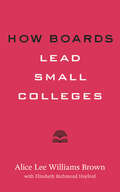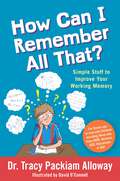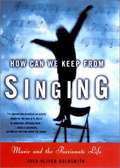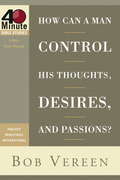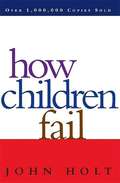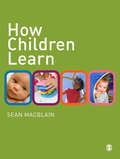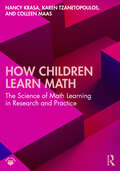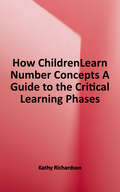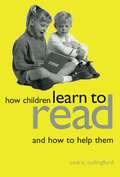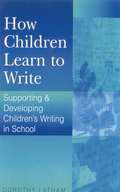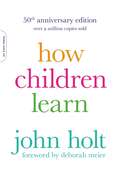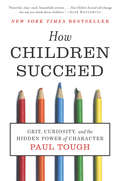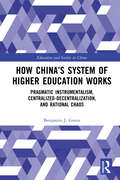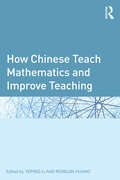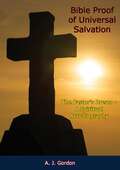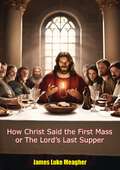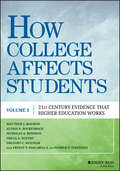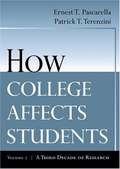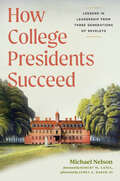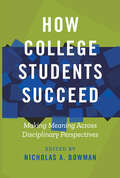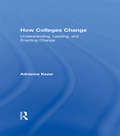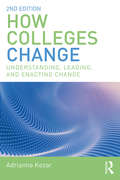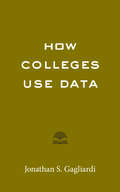- Table View
- List View
How Boards Lead Small Colleges (Higher Ed Leadership Essentials)
by Alice Lee BrownA college is only as strong as its board of trustees.While the media frequently report on threats facing colleges and universities, no sector of higher education is in more danger than private colleges with small endowments and low enrollments. Numerous small private liberal arts colleges could benefit from careful consideration of characteristics and practices of successful trusteeship. In How Boards Lead Small Colleges, Alice Lee Williams Brown and Elizabeth Richmond Hayford focus on small colleges—the kind that seldom attract the attention of researchers. Integrating case studies with theoretical analyses of college governance, they explain the basic responsibilities of boards while demonstrating how some develop practices that fulfill these responsibilities more effectively than others. The book emphasizes strategic planning and collaboration between the board and central administration—advice useful to those governing colleges and universities of all sizes and strengths.For decades, the authors led consortia of small colleges and served on boards of multiple nonprofit organizations. Here, they interview trustees and presidents at dozens of small colleges across multiple states to identify the role governing boards play in building strong private colleges. Encouraging presidents to consider new approaches for working with their boards based on mutual dedication to strengthening institutions, Brown and Hayford also urge trustees to challenge new thinking from their presidents without interfering in internal operations. How Boards Lead Small Colleges is designed to appeal to anyone with a special interest in the future of small private colleges, which play a critical role in the world of higher education.
How Can I Remember All That?: Simple Stuff to Improve Your Working Memory
by Tracy Packiam Packiam AllowayWhy can't I remember what my parents just asked me to do? Why do I feel stressed out at school when the teacher is writing on the board and talking at the same time? And what can I do about it? Working memory issues affect a huge proportion of kids with learning differences like ADHD, dyslexia, dyscalculia, and ASD. These issues can make them feel frustrated or bored, as working memory and intelligence are two very different things. Kids with working memory problems can also act out in the classroom and at home. In this child-friendly and authoritative guide, international working memory expert Dr Tracy Packiam Alloway walks you through what working memory is, what it feels like to have problems with your working memory, and what you can do about it. She presents key tips and strategies, such as the benefits of eating chocolate or of barefoot running, that will help children both at home and at school, and includes a section at the end for adults describing how we can test for working memory issues.
How Can People Help Communities? (Community Questions)
by Martha E. RustadA community is only as strong as its individual members. What roles do those members play, and how do citizens work together to complete common tasks and achieve goals? A clear question-answer format, paired with photos kids can relate to, shows the importance of responsibility and cooperation. A simple activity encourages young readers to actively participate in their own community.
How Can We Keep from Singing: Music and the Passionate Life
by Joan Oliver GoldsmithThe author has been a member of the Minneapolis/St. Paul Symphony Chorus for eight years, and has a lifelong love of choral singing. This book combines memoir with far-ranging reflections on singing, friendship, the corporate world, romantic love, and much more. Goldsmith writes beautifully and her words capture the beauty and exhilaration of singing, which she considers a spiritual experience.
How Can a Man Control His Thoughts, Desires, and Passions?
by Bob VereenChristian men are in the midst of a life-long process. They're being transformed by the renewing of their minds, and through the power of the Holy Spirit, they're crucifying the sinful nature with its passions and desires. But the world, the flesh, and the devil go to great lengths to thwart the process. Our culture is obsessed with sex. Pornography, declining morals, pervasive visual stimulation, rampant divorce, and epidemic adultery. They all reflect ungodly passions. And inflame impure thoughts. In this six-week study you'll learn that God has provided everything you need to resist temptation. Through the examples of men in Scripture-those who fell into sin and those who stood firm-you'll find hope for controlling your passions. You'll learn how to choose the path of purity. And you'll find assurance that through the power of the Holy Spirit and God's Word, you can escape the corruption of this world and one day stand before God blameless and pure.
How Children Fail (Classics In Child Development Series)
by John HoltFirst published in the mid 1960s, How Children Fail began an education reform movement that continues today. <P><P>In his 1982 edition, John Holt added new insights into how children investigate the world, into the perennial problems of classroom learning, grading, testing, and into the role of the trust and authority in every learning situation. His understanding of children, the clarity of his thought, and his deep affection for children have made both How Children Fail and its companion volume, How Children Learn, enduring classics.
How Children Learn
by Sean MacblainUnderstanding How Children Learn is a vital part of working with children. Every child is unique and understanding differences in learning helps all to benefit. This book goes beyond simply understanding the work of key theorists and the various theories of learning to recognise what learning actually looks like and how it is best facilitated in any setting. Each chapter includes: Exercises to help you evaluate your understanding and practice Examples taken from real experiences to illustrate concepts beyond the theory Summaries to help you take the key messages from each chapter Suggestions for further reading to help push your own learning further. Looking at key topics such as brain development, technology in childhood and barriers to learning, this book will explain what learning really is. Why not also have a look at the companion title Learning Theories in Childhood to explore the key learning theories? Sean MacBlain is Reader in Child Development and Disability at the University of St. Mark & St. John, Plymouth.
How Children Learn Math: The Science of Math Learning in Research and Practice
by Nancy Krasa Karen Tzanetopoulos Colleen MaasWritten for pre-service and in-service educators of children in preschool through grade five, this book connects research in cognitive development and math education to offer an accessibly written and practical introduction to the science of elementary math learning. Structured according to children’s mathematical development, How Children Learn Math systematically reviews and synthesizes the latest developmental research on mathematical cognition into accessible sections that explain both the scientific evidence available and its practical classroom application. Written by an author team with decades of collective experience in cognitive learning research, clinical learning evaluations, and classroom experience working with both teachers and children, this amply illustrated text offers a powerful resource for understanding children’s mathematical development, from quantitative intuition to word problems, and helps readers understand and identify math learning difficulties that may emerge in later grades. Aimed at pre-service and in-service teachers and educators with little background in cognitive development, the book distills important findings in cognitive development into clear, accessible language and practical suggestions. The book therefore serves as an ideal text for pre-service early childhood, elementary, and special education teachers, as well as early career researchers, or as a professional development resource for in-service teachers, supervisors and administrators, school psychologists, homeschool parents, and other educators.
How Children Learn Number Concepts: A Guide to the Critical Learning Phases
by Kathy RichardsonA must-have book for everyone wanting to know how young children develop and understanding of number concepts. Kathy Richardson has identified the predictable stages, or Critical Learning Phases, children go through as they develop the mathematical understanding that is essential to building a solid foundation of numerical reasoning. This important resource will help all math educators and parents of young children understand how children make sense of numbers and what mathematics they are ready to learn at each phase of development.
How Children Learn to Read and How to Help Them
by Cedric CullingfordThis is an introductory guide to the theoretical and practical aspects of the development of reading skills. The book looks at the success or failure of various techniques and provides underpinning theory.
How Children Learn to Write: Supporting and Developing Children's Writing in School
by Dorothy Latham`This book is a useful addition to any staff library. What makes it different to many other similar books is that it shows teachers that speaking, listening and reading create the foundations for writing. Tested in schools, staff said: "It is a very useful framework for action-research based upon secure theory. When deciding classroom strategies, it is easy to find what you are looking for and the chapter summaries are very helpful. Some of the staff development and training suggestions are very practical and we are trying them out. We found the emphasis upon class novels and the class discussion that follows, very important, especially when linked to the excellent examples of children's writing." This book may appear to some as theoretical and 'academic', but this is why it will be valuable. It does what the title says because it shows how children learn to write. It starts at the beginning and saves diving into the latest trend. Perhaps its best recommendation is that every school that was asked to look at it said, `It's good and we have ordered a copy' - John Lilly, independent education consultant `The chapter on the Taxonomy of Writing Purposes will be useful for planning and those on extending and enhancing writing will definitely be helpful in many day-to-day situations' - Nicholas Bielby, Times Educational Supplement This book outlines the processes which are involved when children learn to write. The author shows how certain strategies can improve children's progress in writing. Dealing with the age range three to 13, the book addresses issues to do with: - the gender gap - children with English as an additional language - left-handedness Dorothy Latham includes ideas for sound and easy ongoing assessment of writing. The book is written in line with the requirements of the English National Curriculum and The National Literacy Strategy Framework for England, but is not limited to them. Topics also covered include: - brain development and structures - the acquisition of speech - language and thinking - working memory - secretarial skills - stages in compositional development - writing purposes and cross-curricular applications - strategies for improving self-generated writing - using reading to improve writing - using speech and drama to improve writing and - ten ways to improve children's writing. This book is for serving teachers in schools wishing to study the subject in further depth, and as a source book for students. Useful for school-based staff INSET, it provides simple activities for teachers to do and discuss.
How Children Learn, 50th anniversary edition (A Merloyd Lawrence Book)
by John HoltFrom the preface by Deborah Meier:"We have a long way to go to make John Holt's dream available to all children. But his books make it possible and easier for many of us to join him in the journey."In this enduring classic, rich with deep, original insight into the nature of early learning, John Holt was the first to make clear that, for small children, "learning is as natural as breathing." In his delightful book he observes how children actually learn to talk, to read, to count, and to reason, and how, as adults, we can best encourage these natural abilities in our children.
How Children Succeed: Rethinking Character and Intelligence
by Paul Tough<P>Why do some children succeed while others fail? <P>The story we usually tell about childhood and success is the one about intelligence: success comes to those who score highest on tests, from preschool admissions to SATs. <P>But in How Children Succeed, Paul Tough argues that the qualities that matter most have more to do with character: skills like perseverance, curiosity, conscientiousness, optimism, and self-control. <P>How Children Succeed introduces us to a new generation of researchers and educators who, for the first time, are using the tools of science to peel back the mysteries of character. Through their stories--and the stories of the children they are trying to help--Tough traces the links between childhood stress and life success. He uncovers the surprising ways in which parents do--and do not--prepare their children for adulthood. And he provides us with new insights into how to help children growing up in poverty. <P>Early adversity, scientists have come to understand, can not only affect the conditions of children's lives, it can alter the physical development of their brains as well. But now educators and doctors around the country are using that knowledge to develop innovative interventions that allow children to overcome the constraints of poverty. And with the help of these new strategies, as Tough's extraordinary reporting makes clear, children who grow up in the most painful circumstances can go on to achieve amazing things. <P>This provocative and profoundly hopeful book has the potential to change how we raise our children, how we run our schools, and how we construct our social safety net. It will not only inspire and engage readers, it will also change our understanding of childhood itself.
How China’s System of Higher Education Works: Pragmatic Instrumentalism, Centralized-Decentralization, and Rational Chaos (Education and Society in China)
by Benjamin J. GreenGreen sheds light onto the mercurial and ill-defined boundaries of institutional governance within China’s unique system of higher education, a national system that remains misunderstood by scholars who continue to position it as little more than a research arm of the party/state. Through a synthesis of systems theory, complexity theory, and institutional logics, Green provides a relational accounting of "Higher Education with Chinese Characteristics" – a complex, adaptive social system whose paradoxical modernization ideology of pragmatic instrumentalism, in conjunction with a centralized-decentralized governance model, foments rational chaos at the institutional level. Specifically, his book highlights the concept of rational chaos – an observable phenomenon of evolutionary emergence experienced by subaltern actors engaged with the confusing and often paradoxical institutional logics of meso/micro-level governance. Moreover, developed through in-depth narrative interviews, Green’s conceptualization of collective-individualism provides a glimpse into the diverse patterns of identity that have developed within a single institutional governance context. These discrete identity formations, patterned through varying understandings of individual self-determinism, collective role fulfillment, norms and structures of governance, and subsequent changemaking efforts, call into question culturally deterministic research surrounding self-mastery, institutional autonomy, and academic freedom within the Chinese higher education context. His book highlights a subaltern institutional lifeworld accounting of higher education governance that will speak to anyone grappling with neoliberal commodification, managerialism, academic nationalism and the increasing onset of transnational academic (im)mobility. It is ideal for students and scholars of international comparative education, higher education governance, and Chinese studies.
How Chinese Teach Mathematics and Improve Teaching (Studies in Mathematical Thinking and Learning Series #4)
by Yeping Li Rongjin HuangHow Chinese Teach Mathematics and Improve Teaching builds upon existing studies to examine mathematics classroom instruction in China. It combines contributions from Chinese scholars with commentary from key Western scholars to offer multiple perspectives in viewing and learning about some important and distinctive features of mathematics classroom instruction. Viewing classroom instruction as part of teachers’ instructional practices, this book goes beyond teachers’ in-classroom instructional practice by also examining Chinese teachers’ approaches and practices in developing and improving teaching. Through this unique approach, How Chinese Teach Mathematics and Improve Teaching expands and unpacks the otherwise fragmented knowledge about Chinese practices in developing and carrying out mathematics classroom instruction. This book is indispensible reading for those interested in Chinese practices in mathematics teaching, and is a key book for teacher educators, school administrators and policy makers in expanding ways of supporting and helping mathematics teachers in instructional development and improvement.
How Christ Came To Church: The Pastor's Dream - A Spiritual Autobiography
by A. J. GordonExperience a profound spiritual awakening with A. J. Gordon's How Christ Came to Church: The Pastor's Dream - A Spiritual Autobiography. This inspiring and deeply personal account offers a glimpse into the transformative journey of A. J. Gordon, a prominent 19th-century pastor, and theologian, whose life and ministry were profoundly changed by a vivid spiritual encounter.In this spiritual autobiography, Gordon recounts a remarkable dream in which Christ Himself appeared and attended his church. This divine visitation serves as the central theme around which Gordon reflects on his own spiritual growth, his calling to ministry, and the ways in which this extraordinary experience reshaped his approach to faith and leadership.How Christ Came to Church is more than just a retelling of a dream; it is a heartfelt exploration of the nature of true Christian ministry and the presence of Christ in the life of the believer. Gordon's narrative delves into the impact of this experience on his preaching, his pastoral care, and his personal devotion, offering readers a vivid portrayal of how a single moment of divine intervention can lead to a lifetime of spiritual renewal.Throughout the book, Gordon shares insights and reflections that are both deeply theological and intensely practical. His writing is imbued with a sense of humility and reverence, inviting readers to contemplate their own spiritual journeys and the presence of Christ in their lives. The book challenges readers to seek a more authentic and vibrant faith, grounded in a personal relationship with Jesus.How Christ Came to Church is an essential read for pastors, church leaders, and anyone longing for a deeper, more intimate experience of God’s presence. A. J. Gordon’s eloquent and heartfelt testimony continues to inspire and encourage believers to seek the transformative power of Christ in their own lives and communities.
How Christ Said the First Mass or The Lord's Last Supper: The Rites And Ceremonies, The Ritual And Liturgy, The Forms Of Divine Worship Christ Observed, When He Changed The Passover Into The Mass (classic Reprint)
by James Luke MeagherWORLDLY people look with wonder at the Mass, and often say: “What is the meaning of this form of divine worship? Where did these ceremonies come from? Why are candles lighted during daytime? Why do the priests wear such peculiar robes? Why don't they say the service in a language the people can understand?”The Catholic sometimes says to himself: “The Mass came from the Last Supper. But did Christ or the apostles say Mass as priest or bishop of our time? Did Christ that night follow any form of worship? If he did, where is it found? From ancient days the Church used the Ordinary of the Mass, but we do not know its origin.”Many questions rise in people's minds to which they find no answer. A common opinion holds that Christ said the First Mass at the Last Supper according to a short form of blessing and prayer, then consecrated the bread and wine, gave the apostles Communion, and preached the sermon John's Gospel gives. When the apostles said Mass, they recited some Psalms, read the Scriptures, preached a sermon, consecrated the bread and wine, recited the Lord's Prayer and then gave Communion. In the apostolic age the saints added other prayers and ceremonies. Afterwards Popes and councils still developed the rites, composed new prayers, and during the Middle Ages the Mass grew and expanded into the elaborate Liturgy and Ceremonial of our day.But these opinions are wrong. From the beginning the Mass was said according to a long Liturgy and with ceremonies differing little from those of our time. No substantial addition was made after the apostolic age; what the early Popes did was of minor importance, revisions and corrections. Little addition was made to the Ordinary of the Mass handed down from the days of Peter, founder of our Latin Liturgy.
How College Affects Students: 21st Century Evidence that Higher Education Works
by Nicholas A. Bowman Matthew J. Mayhew Alyssa N. Rockenbach Tricia A. Seifert Gregory C. WolniakThe bestselling analysis of higher education's impact, updated with the latest data How College Affects Students synthesizes over 1,800 individual research investigations to provide a deeper understanding of how the undergraduate experience affects student populations. Volume 3 contains the findings accumulated between 2002 and 2013, covering diverse aspects of college impact, including cognitive and moral development, attitudes and values, psychosocial change, educational attainment, and the economic, career, and quality of life outcomes after college. Each chapter compares current findings with those of Volumes 1 and 2 (covering 1967 to 2001) and highlights the extent of agreement and disagreement in research findings over the past 45 years. The structure of each chapter allows readers to understand if and how college works and, of equal importance, for whom does it work. This book is an invaluable resource for administrators, faculty, policymakers, and student affairs practitioners, and provides key insight into the impact of their work. Higher education is under more intense scrutiny than ever before, and understanding its impact on students is critical for shaping the way forward. This book distills important research on a broad array of topics to provide a cohesive picture of student experiences and outcomes by: Reviewing a decade's worth of research; Comparing current findings with those of past decades; Examining a multifaceted analysis of higher education's impact; and Informing policy and practice with empirical evidence Amidst the current introspection and skepticism surrounding higher education, there is a massive body of research that must be synthesized to enhance understanding of college's effects. How College Affects Students compiles, organizes, and distills this information in one place, and makes it available to research and practitioner audiences; Volume 3 provides insight on the past decade, with the expert analysis characteristic of this seminal work.
How College Affects Students: A Third Decade of Research
by "Ernest T. Pascarella Patrick T. Terenzini"This is the long-awaited second volume of Pascarella and Terenzinis 1991 award-winning review of the research on the impacts of college on students. The authors review their earlier findings and then synthesize what has been learned since 1990 about colleges influences on students learning.
How College Presidents Succeed: Lessons in Leadership from Three Generations of Reveleys
by Michael NelsonLeadership lessons in higher education and what they can teach us about leadership in all walks of life In an era when college presidents serve for on average fewer than six years—leaving out of personal ambition for a next post or being forced to leave under fire—there is an inspirational counterexample of leaders dedicated to the long-term success of their institutions. This book weaves together the stories behind what the Washington Post dubbed &“Virginia&’s academic dynasty&” to determine what makes for sound and effective institutional leadership. Here are the lessons of three generations of college presidents from one family, the Reveleys, who have successfully led major colleges and universities across the commonwealth of Virginia for decades, an ongoing legacy unrivaled in modern American higher education. All three generations of Reveleys profiled here successfully dealt with the challenges of stewarding varied institutions—Hampden-Sydney College, William & Mary, and Longwood University—in a politically and demographically evolving state embedded within an equally dynamic and complex national, economic, and cultural environment for higher education. Now, in the Reveleys&’ own words—drawn from more than one hundred hours of oral interviews and thousands of pages of personal papers—this book tells their story and offers readers insights into best leadership practices gleaned from their unparalleled cumulative experience.
How College Students Succeed: Making Meaning Across Disciplinary Perspectives
by Nicholas A. BowmanReceiving a college education has perhaps never been more important than it is today. While its personal, societal, and overall economic benefits are well documented, too many college students fail to complete their postsecondary education. As colleges and universities are investing substantial resources into efforts to counter these attrition rates and increase retention, they are mostly unaware of the robust literature on student success that is often bounded in disciplinary silos. The purpose of this book is to bring together in a single volume the extensive knowledge on college student success. It includes seven chapters from authors who each synthesize the literature from their own field of study, or perspective. Each describes the theories, models, and concepts they use; summarizes the key findings from their research; and provides implications for practice, policy, and/or research. The disciplinary chapters offer perspectives from higher education, public policy, behavioral economics, social psychology, STEM, sociology, and critical and post-structural theory.
How College Works
by Daniel F. Chambliss Christopher G. TakacsConstrained by shrinking budgets, can colleges do more to improve the quality of education? And can students get more out of college without paying higher tuition? Daniel Chambliss and Christopher Takacs conclude that the limited resources of colleges and students need not diminish the undergraduate experience. How College Works reveals the surprisingly decisive role that personal relationships play in determining a student's collegiate success, and puts forward a set of small, inexpensive interventions that yield substantial improvements in educational outcomes. At a liberal arts college in New York, the authors followed a cluster of nearly one hundred students over a span of eight years. The curricular and technological innovations beloved by administrators mattered much less than the professors and peers whom students met, especially early on. At every turning point in students' undergraduate lives, it was the people, not the programs, that proved critical. Great teachers were more important than the topics studied, and even a small number of good friendships--two or three--made a significant difference academically as well as socially. For most students, college works best when it provides the daily motivation to learn, not just access to information. Improving higher education means focusing on the quality of a student's relationships with mentors and classmates, for when students form the right bonds, they make the most of their education.
How Colleges Change: Understanding, Leading, and Enacting Change
by Adrianna KezarHigher education is in an unprecedented time of change and reform. To address these challenges, university leaders tend to focus on specific interventions and programs, but ignore the change processes and the contexts that would lead to success. Joining theory and practice, How Colleges Change unmasks problematic assumptions that change agents typically possess and provides research-based principles for approaching change. Framed by decades of research, this monumental book offers fresh insights into understanding, leading, and enacting change. Recognizing that internal and external conditions shape and frame change processes, Kezar presents an overarching practical framework that can be applied to any organizational challenge and context. How Colleges Change is a crucial resource for aspiring and practicing campus leaders, higher education practitioners, scholars, faculty, and staff who want to learn how to apply change strategies in their own institutions.
How Colleges Change: Understanding, Leading, and Enacting Change
by Adrianna KezarJoining theory and practice, How Colleges Change unmasks problematic assumptions that university leaders and change agents typically possess, and provides research-based principles for approaching change. Featuring case studies, teaching questions, change tools, and a greater focus on scaling change, this monumental new edition offers updated content and fresh insights into understanding, leading, and enacting change. Recognizing that internal and external conditions shape and frame change processes, Kezar presents an overarching practical toolkit—a framework for analyzing change, as well as a set of theoretical perspectives to apply that framework in order to custom-design a change process, no matter the organizational challenge or context. How Colleges Change is a crucial resource for aspiring and practicing campus leaders, higher education practitioners, scholars, faculty, and staff who want to become agents of change in their own institutions.
How Colleges Use Data (Higher Ed Leadership Essentials)
by Jonathan S. GagliardiWhat does a culture of evidence really look like in higher education?The use of big data and the rapid acceleration of storage and analytics tools have led to a revolution of data use in higher education. Institutions have moved from relying largely on historical trends and descriptive data to the more widespread adoption of predictive and prescriptive analytics. Despite this rapid evolution of data technology and analytics tools, universities and colleges still face a number of obstacles in their data use. In How Colleges Use Data, Jonathan S. Gagliardi presents college and university leaders with an important resource to help cultivate, implement, and sustain a culture of evidence through the ethical and responsible use and adoption of data and analytics. Gagliardi provides a broad context for data use among colleges, including key concepts and use cases related to data and analytics. He also addresses the different dimensions of data use and highlights the promise and perils of the widespread adoption of data and analytics, in addition to important elements of implementing and scaling a culture of evidence.Demystifying data and analytics, the book helps faculty and administrators understand important topics, including:• How to define institutional aspirations using data• Equity and student success• Strategic finance and resource optimization• Academic quality and integrity• Data governance and utility• Implicit and explicit bias in data• Implementation and planning• How data will be used in the futureHow Colleges Use Data helps college and university leaders understand what a culture of evidence in higher education truly looks like.
